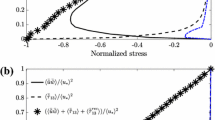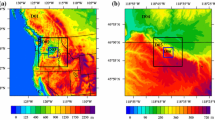Abstract
The sensitivity of large-eddy simulation (LES) to the representation of subgrid-scale (SGS) processes is explored for the case of the convective boundary layer (CBL) developing over surfaces with varying degrees of spatial heterogeneity. Three representations of SGS processes are explored: the traditional constant Smagorinsky–Lilly model and two other dynamic models with Lagrangian averaging approaches to calculate the Smagorinsky coefficient (C S ) and SGS Prandtl number (Pr). With initial data based roughly on the observed meteorology, simulations of daytime CBL growth are performed over surfaces with characteristics (i.e. fluxes and roughness) ranging from homogeneous, to striped heterogeneity, to a realistic representation of heterogeneity as derived from a recent field study. In both idealized tests and the realistic case, SGS sensitivities are mostly manifest near the surface and entrainment zone. However, unlike simulations over complex domains or under neutral or stable conditions, these differences for the CBL simulation, where large eddies dominate, are not significant enough to distinguish the performance of the different SGS models, irrespective of surface heterogeneity.
Similar content being viewed by others
References
Albertson JD and Parlange MB (1999a). Surface length scale and shear stress: implication for land-atmosphere interaction over complex terrain. Water Resour Res 35: 2121–2132
Albertson JD and Parlange MB (1999b). Natural integration of scalar fluxes from complex terrain. Adv Water Resour 23: 239–252
Albertson JD, Kustas WP and Scanlon TM (2001). Large-eddy simulation over heterogeneous terrain with remotely sensed land surface condition. Water Resour Res 37: 1939–1953
Avissar R and Schmidt T (1998). An evaluation of the scale at which ground-surface heat flux patchiness affects the convective boundary layer using large-eddy simulation. J Atmos Sci 55: 2666–2689
Avissar R, Eloranta EW, Gurer K and Tripoli GJ (1998). An evaluation of the large-eddy simulation option of the RAMS in simulating a convective boundary layer: a FIFE case study. J Atmos Sci 55: 1109–1130
Basu S and Porté-Agel F (2006). Large-eddy simulation of stably stratified boundary layer turbulence: a scale-dependent dynamic modeling approach. J Atmos Sci 63: 2074–2091
Bou-Zeid E, Meneveau C and Parlange MB (2004). Large-eddy simulation of neutral atmospheric boundary layer flow over heterogeneous surfaces: blending height and effective surface roughness. Water Resour Res 40: W02505
Bou-Zeid E, Meneveau C and Parlange MB (2005). A scale-dependent Lagrangian dynamic model for large eddy simulation of complex turbulent flows. Phys Fluids 17: 025105
Businger JA (1973) Turbulent transfer in the atmospheric surface layer. In: Workshop on Micrometeorology. American Meteorological Society, Boston, pp 67–100
Cai XM (1999). Large-eddy simulation of the convective boundary layer over an idealized patchy urban surface. Quart J Roy Meteorol Soc 125: 1427–1444
Crow WT, Li FQ and Kustas WP (2005). Intercomparison of spatially distributed models for predicting surface energy flux patterns during SMACEX. J Hydrometeorol 6: 941–953
Deardorff JW (1972). Numerical investigation of neutral and unstable planetary boundary layers. J Atmos Sci 29: 91–115
Deardorff JW (1974). Three-dimensional numerical study of turbulence in an entraining mixed layer. Boundary-Layer Meteorol 7: 199–226
Eichinger WE, Holder HE, Cooper DI, Hipps LE, Knight R, Kustas WP, Nichols J and Prueger JH (2005). Lidar measurement of boundary layer evolution to determine sensible heat fluxes. J Hydrometeol 6: 840–853
Esau I (2004). Simulation of Ekman boundary layers by large eddy model with dynamic mixed subfilter closure. Environ Fluid Mech 4(3): 273–303
Fedorovich E, Conzemius R, Esau I, Chow FK, Lewellen D, Moeng CH, Sullivan P, Pino D, Vila-Guerau de Arellano J (2004) Entrainment into sheared convective boundary layers as predicted by different large eddy simulation codes. Paper P4.7. 16th symposium on boundary layers and turbulence. American Meteorological Society, 14 pp
Germano M, Piomelli U, Moin P and Cabot WH (1991). A dynamic subgrid-scale eddy viscosity model. Phys Fluids A 3: 1760–1765
Ghosal S, Lund TS, Moin P and Akselvoll K (1995). A dynamic localization model for large-eddy simulation of turbulence flows. J Fluid Mech 286: 229–255
Hadfield MG, Cotton WR and Pielke RA (1991). Large-eddy simulation of thermally forced circulation in the convective boundary layer, Part I: a small-scale circulation with zero wind. Boundary-Layer Meteorol 57: 79–114
Hechtel LM, Moeng CH and Stull RB (1990). The effect of nonhomogeneous surface fluxes on the convective boundary layer: a case study using large-eddy simulation. J Atmos Sci 47: 1721–1741
Horiuti K (1987). Comparison of conservative and rotational forms in large eddy simulation of turbulent channel flow. J Comp Phys 71: 343–370
Kleissl J, Parlange MB and Meneveau C (2004). Field experimental study of dynamic Smagorinsky models in the atmospheric surface layer. J Atmos Sci 61: 2296–2307
Kleissl J, Kumar V, Meneveau C and Parlange MB (2006). Numerical study of dynamic Smagorinsky models in large-eddy simulation of the atmospheric boundary layer: validation in stable and unstable conditions. Water Resour Res 42: W06D10
Kumar V, Kleissl J, Meneveau C and Parlange MB (2006). Large-eddy simulation of a diurnal cycle of the atmospheric boundary layer: atmospheric stability and scaling issues. Water Resour Res 42: W06D09
Kustas WP, Hatfield JL and Prueger JH (2005). The soil moisture-atmosphere coupling experiment (SMACEX): background, hydrometeorological conditions, and preliminary findings. J Hydrometeorol 6: 791–804
Lilly DK (1962). On the numerical simulation of buoyant convection. Tellus 14: 148–172
Lilly DK (1967) The representation of small-scale turbulence in numerical simulations. In Proceedings of IBM scientific computing symposium on environmental sciences, IBM form no. 320–1951. White Plains, New York, pp 195–209
Lin CL and Glendening JW (2002). Large eddy simulation of an inhomogeneous atmospheric boundary layer under neutral conditions. J Atmos Sci 59: 2479–2497
Majander P (2000) Development in large eddy simulation. Report 128, Laboratory of Applied Thermodynamics, Helsinki University of Technology, 112 pp
Mason PJ (1989). Large-eddy simulation of the convective atmospheric boundary layer. J Atmos Sci 46: 1492–1516
Mason PJ and Callen NS (1986). On the magnitude of the subgrid-scale eddy coefficient in large-eddy simulations of turbulent channel flow. J Fluid Mech 162: 439–462
Meneveau C, Lund TS and Cabot WH (1996). A Lagrangian dynamic subgrid-scale model of turbulence. J Fluid Mech 319: 353–385
Moeng CH (1984). A large-eddy-simulation model for the study of planetary boundary layer. J Atmos Sci 41: 2052–2062
Moeng CH and Wyngaard JC (1984). Statistic of conservative scalars in the convective boundary layer. J Atmos Sci 41: 3161–3169
Moin P and Kim J (1982). Numerical investigation of turbulent channel flow. J Fluid Mech 118: 341–377
Nieuwstadt FTM, Mason PJ, Moeng CH, Schumann U (1991) Large-eddy simulation of the convective boundary layer: a comparison of four computer codes. In: Turbulent shear flows, vol 8. Springer, pp 343–367
Patton EG, Sullivan PP and Moeng CH (2005). The influence of idealized heterogeneity on wet and dry planetary boundary layers coupled to the land surface. J Atmos Sci 62: 2078–2097
Porté-Agel F (2004). A scale-dependent dynamic model for scalar transport in large-eddy simulations of the atmospheric boundary layer. Boundary-Layer Meteorol 112: 81–105
Porté-Agel F, Meneveau C and Parlange MB (2000). A scale-dependent model for large-eddy simulation: application to a neutral atmospheric boundary layer. J Fluid Mech 415: 261–284
Porté-Agel F, Parlange MB, Meneveau C and Eichinger WE (2001). A priori field study of subgrid-scale heat fluxes and dissipation in the atmospheric surface layer. J Atmos Sci 58: 2673–2698
Prueger JH, Hatfield JL, Kustas WP, Hipps LE, MacPherson JI, Neale CMU, Eichinger WE, Cooper DI and Parkin TB (2005). Tower and aircraft eddy covariance measurements of water vapor, energy, and carbon dioxide fluxes during SMACEX. J Hydrometeorol 6: 954–960
Schmidt H and Schumann U (1989). Coherent structure of the convective boundary-layer derived from large-eddy simulations. J Fluid Mech 200: 511–562
Smagorinsky J (1963). General circulation experiments with the primitive equations. Mon Wea Rev 91: 99–165
Stevens B (2000a). Quasi-steady analysis of a PBL model with an eddy-diffusivity profile and non-local fluxes. Mon Wea Rev 128: 824–836
Stevens B (2000b). Cloud transition and decoupling in shear-free stratocumulus-topped boundary layers. Geophys Res Lett 27: 2557–2560
Stevens B (2002). Entrainment in stratocumulus-topped mixed layers. Quart J Roy Meteorol Soc 128: 2663–2690
Stevens B (2007). On the growth of layers of non-precipitating cumulus convection. J Atmos Sci 64: 2916–2931
Stevens B, Moeng CH and Sullivan PP (1999). Large-eddy simulations of radiatively driven convection: sensitivities to the representation of small scales. J Atmos Sci 56: 3963–3984
Stevens B, Moeng CH and Ackerman AS et al (2005). Evaluation of large-eddy simulations via observations of nocturnal marine stratocumulus. Mon Wea Rev 133: 1443–1462
Stoll R and Porté-Agel F (2006a). Effect of roughness on surface boundary conditions for large-eddy simulation. Boundary-Layer Meteorol 118: 169–187
Stoll R and Porté-Agel F (2006b). Dynamic subgrid-scale models for momentum and scalar fluxes in large-eddy simulations of neutrally stratified atmospheric boundary layers over heterogeneous terrain. Water Resour Res 42: W01409
Sullivan PP, McWilliams JC and Moeng CH (1994). A subgrid-scale model for large-eddy simulation of planetary boundary-layer. Boundary-Layer Meteorol 71: 247–276
Taylor PA (1987). Comments and further analysis on effective roughness lengths for use in numerical three-dimensional models. Boundary-Layer Meteorol 39: 403–418
Tennekes H and Driedonks AGM (1981). Basic entrainment equations for the atmospheric boundary layer. Boundary-Layer Meteorol 20: 515–531
Zang Y, Street RL and Koseff JR (1993). A dynamic mixed subgrid-scale model and its application to turbulent recirculating flows. Phys Fluids A 5: 3186–3196
Author information
Authors and Affiliations
Corresponding author
Rights and permissions
About this article
Cite this article
Huang, HY., Stevens, B. & Margulis, S.A. Application of Dynamic Subgrid-scale Models for Large-eddy Simulation of the Daytime Convective Boundary Layer over Heterogeneous Surfaces. Boundary-Layer Meteorol 126, 327–348 (2008). https://doi.org/10.1007/s10546-007-9239-9
Received:
Accepted:
Published:
Issue Date:
DOI: https://doi.org/10.1007/s10546-007-9239-9




